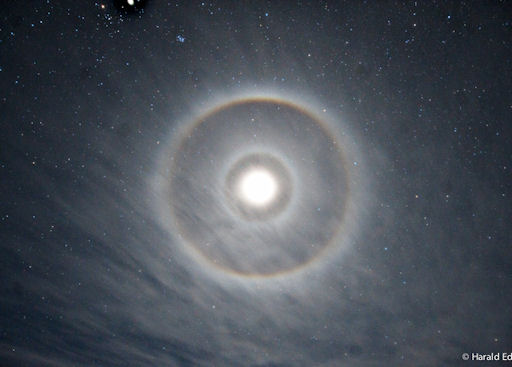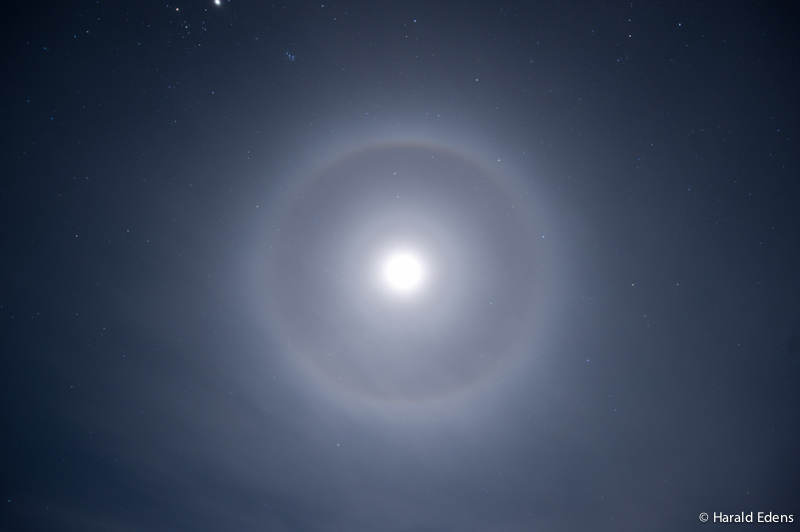"Just after 7 PM local time I noticed a bright 22-degree halo around the moon," says Edens. "It was only when I started photographing that halo when I discovered a rare 9-degree halo inside the 22-degree halo."
The inner 9-degree halo is caused by ice crystals in the shape of pyramids. "Apart from the 9-degree circular halo, an 18-degree and perhaps a 35-degree circular halo were also present at times," he adds. All of these "odd-radius" halos are caused by icy pyramids.
The display quickly became even more varied. Edens saw at least a dozen different kinds of luminous rings and arcs, enumerated in his complete description of the event. "The display was highly transient," he notes. "Not only did the cirrus move fairly swiftly in the sky, but the halos - especially the odd-radius halos - appeared to come and go over the course of just a few minutes." But what a few minutes it was!
Details
This has been the most rare and memorable halo display that I have witnessed over the past 10 years while living in the state of New Mexico. It is over 13 years ago that I last saw halos from pyramidal ice crystals in the sky.
Just after 7 PM local time (MST) I noticed a bright 22-degree halo around the moon. It was only when I started photographing that halo when I discovered the rare 9-degree halo within the 22-degree halo. This was the start of a lengthy halo observing and photography session that lasted until moonset around 2 AM local time. Apart from the 9-degree circular halo, an 18-degree and perhaps the 35-degree circular halo were also present at times.
Close to the time when the moon culminated and was high in the sky, there was a brief moment when the 22-degree halo was accompanied by a circumscribed halo, upper and lower Parry arcs, a tiny paraselenic circle with a radius of only about that of the 22-degree halo, and an infralateral arc. Its possible that the tangent arc that appears separate from the circumscribed halo in the photograph is in fact a 23-degree upper parhelion and not a Parry arc; I am unsure. There is a lower Parry arc visible at the lower right, separating from the 22-degree and circumscribed halos.
The lunar halo display was highly transient. Not only did the cirrus move fairly swiftly in the sky, but the halos - especially the odd-radius halos - appeared to come and go over the course of just minutes.
The halos that I've been able to confirm from the photographs are:
Circular halos: 9, 18, 22 degree (certain) and 35 degree (uncertain);
Circumscribed halo (and upper/lower tangent arcs later on);
Supralateral arc;
Infralateral arc;
Upper suncave Parry arc;
23-degree upper parhelion (uncertain);
Lower suncave Parry arc;
Paraselenic circle;
Paraselenia (22 degree).
I intended to submit more than 4 photos, but the upload form has a limit. They wont be on my website anytime soon, so if you or Les Cowley are interested, contact me and Id be happy to provide the set of 14 photos that I selected from the hundreds that I took.
Photos were taken with a 16-mm fisheye lens, a Nikon 24-70/2.8 lens and a Nikon 14-24/2.8 lens, all with a Nikon D700 digital camera. The filenames have the UTC date and time when the file was created in the camera. Unfortunately the camera sensor was full of dust particles and initially I did not want to interrupt my observations to clean it.
~ Harold Edens





Comment: Moon halos usually appear in conjunction with a full moon, but on 21st December the moon was only at first quarter. Besides producing two halos, the planet's changing atmosphere probably made it appear to be full.
See also: Chemtrails, Disinformation and the Sixth Extinction